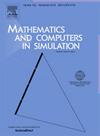基于左右四步规则求解未来Sylvester方程的离散梯度归零神经网络算法以及机械臂逆运动学
IF 4.4
2区 数学
Q1 COMPUTER SCIENCE, INTERDISCIPLINARY APPLICATIONS
引用次数: 0
摘要
时变Sylvester方程(TVSE)在应用数学中,特别是在最优控制理论和矩阵优化工程应用领域中占有重要地位。在预测建模系统的框架内,未来Sylvester方程(FSE)作为TVSE的离散表现形式出现,其特征是未来信息未知。利用一种新的左右四步(LRFS)规则,在连续梯度归零神经网络(GZNN)模型的基础上,提出了一种精度为5阶的离散梯度归零神经网络(DGZNN)算法来解决FSE问题。该算法被命名为LRFS-DGZNN算法,是一种无逆神经动力学算法。此外,通过Lyapunov稳定性理论和矩阵谱理论,说明了GZNN模型在求解TVSE问题时的收敛性。利用线性多步法的稳定性理论和常微分方程数值逼近理论,建立并证明了LRFS-DGZNN算法在求解FSE问题时的误差模式特性。通过三个数值实验,对所提出的GZNN模型和LRFS-DGZNN算法在求解TVSE问题上的性能进行了评价。并给出了平面2自由度机械臂、Kinova Jaco2 6自由度机械臂和Franka Emika Panda 7自由度机械臂的运动学逆解和仿真,验证了LRFS-DGZNN算法的高效性。本文章由计算机程序翻译,如有差异,请以英文原文为准。
Discrete gradient-zeroing neural network algorithm for solving future Sylvester equation aided with left–right four-step rule as well as robot arm inverse kinematics
The temporal-variant Sylvester equation (TVSE) occupies a significant position in applied mathematics, particularly in the realms of optimal control theory and matrix optimization engineering applications. Within the framework of prediction modeling systems, the future Sylvester equation (FSE) emerges as the discrete manifestation of TVSE, characterized by unknown future information. Leveraging a novel left and right four-step (LRFS) rule, we propose a novel discrete gradient-zeroing neural network (DGZNN) algorithm with order-5 precision, which is developed from the continuous gradient-zeroing neural network (GZNN) model, for solving the FSE problem. The proposed algorithm is named as LRFS-DGZNN algorithm, which stands out as an inverse-less neurodynamic algorithm. Additionally, the convergence properties of the GZNN model in solving the TVSE problem are elucidated through Lyapunov stability theory and matrix spectral theory. Furthermore, the LRFS-DGZNN algorithm’s error pattern property in solving the FSE problem is established and proven using stability theory of linear multi-step methods and ordinary differential equation numerical approximation theory. Three numerical experiments are conducted to evaluate the performance of the proposed GZNN model for solving the TVSE problem and the LRFS-DGZNN algorithm for solving the FSE problem. Moreover, the study showcases the inverse-kinematics solutions and simulations involving planar robot arm with 2 degrees of freedom (DOFs), the Kinova Jaco2 robot arm with 6 DOFs, and the Franka Emika Panda robot arm with 7 DOFs, illustrating the high efficiency of the LRFS-DGZNN algorithm.
求助全文
通过发布文献求助,成功后即可免费获取论文全文。
去求助
来源期刊

Mathematics and Computers in Simulation
数学-计算机:跨学科应用
CiteScore
8.90
自引率
4.30%
发文量
335
审稿时长
54 days
期刊介绍:
The aim of the journal is to provide an international forum for the dissemination of up-to-date information in the fields of the mathematics and computers, in particular (but not exclusively) as they apply to the dynamics of systems, their simulation and scientific computation in general. Published material ranges from short, concise research papers to more general tutorial articles.
Mathematics and Computers in Simulation, published monthly, is the official organ of IMACS, the International Association for Mathematics and Computers in Simulation (Formerly AICA). This Association, founded in 1955 and legally incorporated in 1956 is a member of FIACC (the Five International Associations Coordinating Committee), together with IFIP, IFAV, IFORS and IMEKO.
Topics covered by the journal include mathematical tools in:
•The foundations of systems modelling
•Numerical analysis and the development of algorithms for simulation
They also include considerations about computer hardware for simulation and about special software and compilers.
The journal also publishes articles concerned with specific applications of modelling and simulation in science and engineering, with relevant applied mathematics, the general philosophy of systems simulation, and their impact on disciplinary and interdisciplinary research.
The journal includes a Book Review section -- and a "News on IMACS" section that contains a Calendar of future Conferences/Events and other information about the Association.
 求助内容:
求助内容: 应助结果提醒方式:
应助结果提醒方式:


